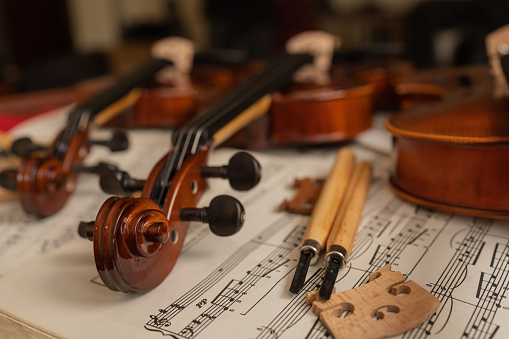A violinist’s bow is as important as the violin itself, as the two must compliment each other to produce a sound that can satisfy the expectations of both performer and listener. This is a basic truth for all violinists, whether they are the concertmaster of a symphony or are a student in middle school still learning to read sheet music. With enough playing time, and some general wear and tear, a violin bow will start to show blemishes, some of which can be repaired or replaced without swapping out the whole bow, but there are times when searching for a replacement is warranted. This is especially true to those whose skills are still in the developing stages, as they require a bow that can meet their growing needs and aspirations.
Knowing when to repair a bow versus buying a new one can be tough to discern, so CodaBow offers this guide with a few key reasons detailing how to tell when your violin bow needs replacement.
Components of a Violin Bow
All violin bows, regardless of what they are made of, consist of five main parts: the bow stick, tip, frog, grip, and hair. While it’s common for bow hairs to break and need replacing, the other bow components are meant to last. However, that does not mean you ought to ignore regular maintenance and upkeep, as these parts may loosen or break due to playing style, climate, and other factors.
Dropped Bows
No one intends to drop their bow on the floor or other hard surfaces, but accidents happen. And when drops happen, unfortunately, a bow can break — especially if it’s made of brazilwood or pernambuco.
If you are a violinist prone to accidents or if you have unsure hands, often dropping items or crashing them into other objects, it may be wise to switch from a bow made of wood to a carbon fiber alternative. As durable as it is, carbon fiber is also a great choice for young violinists. Carbon fiber bows are meant to last forever, with some regular upkeep, making them a wise investment for violinists looking for a bow that rivals Pernambuco. While Pernambuco offers great control and vibrance during performances, it is less durable than a material like carbon fiber. Carbon fiber is five times stronger than steel, but is very light in comparison, rivaling the weight of brazilwood and pernambuco while outlasting in durability.
Routine bow repairs and maintenance, like rehairs, are part of the cost of playing any violin bow. But significant repairs — like replacing or restoring a broken frog or a cracked bow stick — may cost more than the actual value of the bow. A damaged bow can become so devalued it simply may not be financially sensible to repair it. In these instances, unless you have a sentimental attachment to the bow, or it truly meets your musical aspirations, you are likely better off shopping for a new violin bow.
CodaBow Pro Tips with David Auerbach
Using more rosin than you normally would, wondering if it’s time to rehair your bow, or even questioning if you should replace your bow altogether? Get advice from master violist David Auerbach, who shares in the video when he thinks it’s time to rosin, repair, or replace his bow.
Evolving Violin Skills
Beyond the current performance and overall integrity of your bow, does it continue to meet your needs and aspirations, or have you reached a metaphorical wall in your playing? If you are an experienced violinist, you have no doubt expanded your skillset and perhaps even adjusted your playing style over the years. If you are still using an old starter or student bow, perhaps it’s time to upgrade to a new violin bow that better reflects the violinist you have evolved into, rather than one that met your needs as a musician years prior.
At CodaBow, we offer superior quality and sound with each of our carbon fiber bows. Each bow is made of carbon fiber and includes a proprietary blend of organic and composite material infused under high pressure to achieve unrivaled timbre, overtones, and range.
Wondering Whether to Rehair or Replace Your Bow?
If you think your CodaBow is in need of rehairing, instead of replacement, you may submit a service request to the CodaBow Workshop. Depending on playing style and usage, we recommend rehairing your carbon fiber bow every 6 to 12 months. At CodaBow, we use three grades of Mongolian horsehair: student, performance and master-level.
If you prefer to replace your violin bow, explore CodaBow’s collections. We offer industry-leading, award-winning carbon fiber bows for violins, violins and cellos. With our pioneering materials and methods, we adhere to exacting specifications to offer bows that are specifically suited to the performance and preferences of all players.
Feel free to sign up on our email list for additional information for bow servicing and replacement. If you are wanting to see the CodaBow difference, feel free to try an an In-Home Trial.
Fill out the form below to get the download and learn more!



Stay Connected